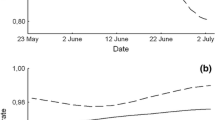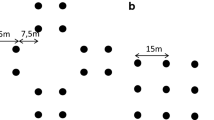Summary
In northern Fennoscandia, microtine rodent populations fluctuate cyclically. The environment of an individual vole can be considered to be predictable when the risks of predation and intra- and interspecific competition change with the cycle, such that both are high during the population highs of voles. The risk of predation is also high during the vole crash. After the crash, the vole population is characterized by low intra- and interspecific competition and low predation pressure. The main predators affecting voles during the crash are the small mustelids, least weasel and stoat. The density of these specialist predators declines drastically during the winter after the vole crash. We studied experimentally the impact of the perceived presence of stoats on the breeding and mating behaviour of voles. In a series of breeding experiments with bank voles,Clethrionomys glareolus, both old and young females suppressed breeding when exposed to the odour of stoats,Mustela erminea. The weights of females decreased in both experimental and control groups, but more among the voles under odour exposition. It seems that females actively avoided copulations under high predation risk and that breeding suppression is mediated by a change in female mating behaviour. There was no change in male behaviour or physical condition between the experimental and control treatments. An alternative mechanism for the observed breeding suppression could be the one caused by decreased feeding in females mediated with low energy intake which does not allow breeding. Regardless of its mechanism, delay of breeding should increase the probability of non-breeding females to survive to the next breeding season. The females surviving the crash should gain a strong selective advantage in a predator-free environment of the subsequent breeding season, which could explain the adaptive function of this antipredatory strategy.
Similar content being viewed by others
References
Abrahams, M.V. and Dill, L.M. (1989) A determination of the energetic equivalence of the risk of predation.Ecology 70, 999–1007.
Bondrup-Nielsen, S. and Ims, R.A. (1986) Reproduction and spacing behaviour of females in a peak density population ofClethrionomys glareolus.Holact. Ecol. 9, 109–12.
Brown, J.S. (1988) Patch use as an indicator of habitat preference, predation risk, and competition.Behav. Ecol Soc. 22, 37–47.
Brown, J.S., Kotler, B.P., Smith, R.J. and Wirz, W.O. II (1988) The effect of owl predation on the foraging behaviour of heteromyid rodents.Oecologia 76, 408–15.
Bruce, H.M. (1959) An exteroceptive block to pregnancy in the mouse.Nature 184, 105.
Bujalska, G. (1973) The role of spacing behaviour among females in the regulation of reproduction in the bank vole.J. Reprod. Fertil. Suppl. 19, 465–74.
Calder, C.J. and Gorman, M.L. (1991) The effects of red foxVulpes vulpes faecal odours on the feeding behaviour of Orkney volesMicrotus arvalis.J. Zool. 224, 599–606.
Cassini, M.H. (1991) Foraging under predation risk in the wild guinea pigCavia aperea.Oikos 61, 1–6.
Crowl, T.A. and Cowich, A.P. (1990) Predator-induced life-history shifts in a freshwater snail.Science 247, 949–51.
Cushing, B.S. (1984) A selective preference by least weasels for oestrous versus dioestrous urine of prairie deer mice.Anim. Behav. 32, 1263–5.
Cushing, B.S. (1985) Estrous mice and vulnerability to weasel predation.Ecology,66, 1976–8.
Endler, J.A. (1987) Predation, light intesity and courtship behaviour inPoecilia reticulata (Pisces: Poeciliidae).Anim. Behav. 35, 1376–85.
Getz, L.L., Dluzen, D. and McDermott, J.L. (1983) Suppression of reproductive maturation in malesimulated virgin femaleMicrotus by a female urinary chemosignal.Behav. Processes 8, 59–64.
Hanski, I., Hansson, L. and Henttonen, H. (1991) Specialist predators, generalist predators, and the microtine rodent cycle.J. Anim. Ecol. 60, 353–67.
Hanski, I., Turchin, P., Korpimäki, E. and Henttonen, H. (1993) Population oscillations of boreal rodents: regulation by mustelid predators leads to chaos.Nature 364, 232–5.
Hansson, L. and Henttonen, H. (1988) Rodent dynamics as community process.Trends Ecol. Evol 3, 195–200.
Heikkilä, J., Kaarsalo, K., Mustonen, O. and Pekkarinen, P. (1993) Influence of predation risk on early development and maturation in three species ofClethrionomys voles.Ann. Zool. Fennici 30, 153–161.
Henttonen, H., Oksanen, T., Jortikka, A. and Haukisalmi, V. (1987) How much do weasels shape microtine cycles in the northern Fennoscandian taiga?Oikos 50, 353–65.
Huntingford, F.A. (1984) Some ethical issues raised by studies of predation and aggression.Anim. Behav. 32, 210–15. Appendix added 1992.
Ims, R.A. (1988) Spatial clumping of sexually receptive females induces space sharing among male voles.Nature 335, 541–3.
Jedrzejewski, W. and Jedrzejewska, B. (1990) Effect of a predator's visit on the spatial distribution of bank voles: experiments with weasels.Can. J. Zool. 68, 660–6.
Kaarsalo, K. and Wallgren, H. (1989) Inhibition of pregnancy and its effects on ovarian follicles inClethrionomys rutilus females exposed to conspecific males and to males ofC. rufocanus. Fifth International Theriological Congress, Rome, 1989, Abstracts, p. 572.
Kaczmarski, F. (1966) Bioenergetics of pregnancy and lactation in the bank vole.Acta Theriol. 11, 409–17.
Koponen, T. (1970) Age structure in sedentary and migratory populations of the Norwegian lemming,Lemmus lemmus (L.), at Kilpisjärvi in 1960.Ann. Zool. Fenn. 7, 141–87.
Korpimäki, E., Norrdahl, K. and Rinta—Jaskari, T. (1991) Response of stoats and least weasels to fluctuating food abundances: is the low phase of the vole cycle due to mustelid predation?Oecologia 88, 552–61.
Kotler, B.P., Brown, J.S., Slotow, R.H., Goodfriend, W.L. and Strauss, M. (1993) The influence of snakes on the foraging behaviour of gerbils.Oikos 67, 309–16.
Lima, S.L. and Dill, L.M. (1990) Behavioural decisions made under the risk of predation: a review and prospectus.Can. J. Zool. 68, 619–40.
Lima, S.L., Valone, T.J. and Caraco, T. (1985) Foraging efficiency — predation risk trade-off in the gray squirrel.Anim. Behav. 33, 155–65.
Lombardi, J.R. and Whitsett, J.M. (1980) Effects of urine from conspecifics on sexual maturation in female prairie deermice,Peromyscus maniculatus bairdii.J. Mammal. 61, 766–8.
McIntosh, T.K. and Drickamer, L. (1977) Excreted urine, bladder urine, and the delay of sexual maturation in female house mice.Anim. Behav. 25, 999–1004.
Magnhagen, C. (1990) Reproduction under predation risk in the sand goby,Potamochistus minutus, and the black goby,Gobius niger: the effect of age and longevity.Behav. Ecol. Soc. 26, 331–5.
Magnhagen, C. (1991) Predation risk as a cost of reproduction.Trends Ecol. Evol. 6, 183–6.
Massey, A. and Vandenbergh, J.G. (1980) Puberty delay by a urinary cue from female house mouse in feral populations.Science 209, 821–2.
Milinski, M. and Heller, R. (1978). Influence of a predator on the optimal foraging behaviour of sticklebacks (Gastreolus aculeatus L.).Nature 275, 642–4.
Ronkainen, H. and Ylönen, H. (1994) Behaviour of cyclic bank voles under risk of mustelid predation: do females avoid copulations?Oecologia (in press).
Sharpe, S.T. and Millar, J.S. (1990) Relocation of nest sites by female deer mice,Peromyscus maniculatus borealis.Can. J. Zool. 68, 2364–7.
Sibly, R. and Calow, P. (1984) Direct and absorption costing in the evolution of life cycles.J. Theor. Biol. 111, 463–73.
Sih, A. (1980) Optimal behavior: can foragers balance two conflicting demands?Science 210, 1041–3.
Sih, A. (1982) Foraging strategies and the avoidance of predation by an aquatic insect,Notonecta hoffmanni.Ecology 63, 786–96.
Sih, A., Krupa, J. and Travers, S. (1990) An experimental study on the effects of predation risk and feeding regime on the mating behavior of the water strider.Am. Nat. 135, 284–90.
Stearns, S.C. and Koella, J.C. (1986) The evolution of phenotypic plasticity in life-history traits: predictions of reaction norms for age and size for maturity.Evolution 40, 892–913.
Viitala, J. (1987) Social organization ofClethrionomys rutilus (Pall.) at Kilpisjärvi, Finnish Lappland.Ann. Zool. Fenn. 24, 267–73.
Watson, M., Clulow, F.V. and Mariotti, F. (1983) Influence of olfactory stimuli on pregnancy of the meadow voleMicrotus pennsylvanicus, in the laboratory.J. Mammal. 64, 706–8.
Wing, S.R. (1988) Cost of mating for female insects: risk of predation inPhotinus collustrans (Coleoptera: Lampyridae).Am. Nat. 131, 139–42.
Ylönen, H. (1989) Weasels suppress reproduction in cyclic bank volesClethrionomys glareolus.Oikos,55, 138–40.
Ylönen, H. (1990) Phenotypic flexibility in the social organization ofClethrionomys. InSocial systems and population cycles in voles (R. H. Tamarin, R.S. Ostfeld, S.R. Pugh and G. Bujalska, eds), pp. 203–12. Birkhäuser, Basel, Boston, Berlin.
Ylönen, H., Kojola, T. and Viitala, J. (1988). Changing female spacing behaviour and demography in an enclosed breeding population ofClethrionomys glareolus.Holarct. Ecol. 11, 286–92.
Ylönen, H., Jedrzejewska, B., Jedrzejewski, W. and Heikkilä, J. (1992) Antipredatory behaviour ofClethrionomys voles — ‘David and Goliath’ arms race.Ann. Zool. Fenn. 29, 207–16.
Author information
Authors and Affiliations
Rights and permissions
About this article
Cite this article
Ylönen, H., Ronkainen, H. Breeding suppression in the bank vole as antipredatory adaptation in a predictable environment. Evol Ecol 8, 658–666 (1994). https://doi.org/10.1007/BF01237848
Issue Date:
DOI: https://doi.org/10.1007/BF01237848




